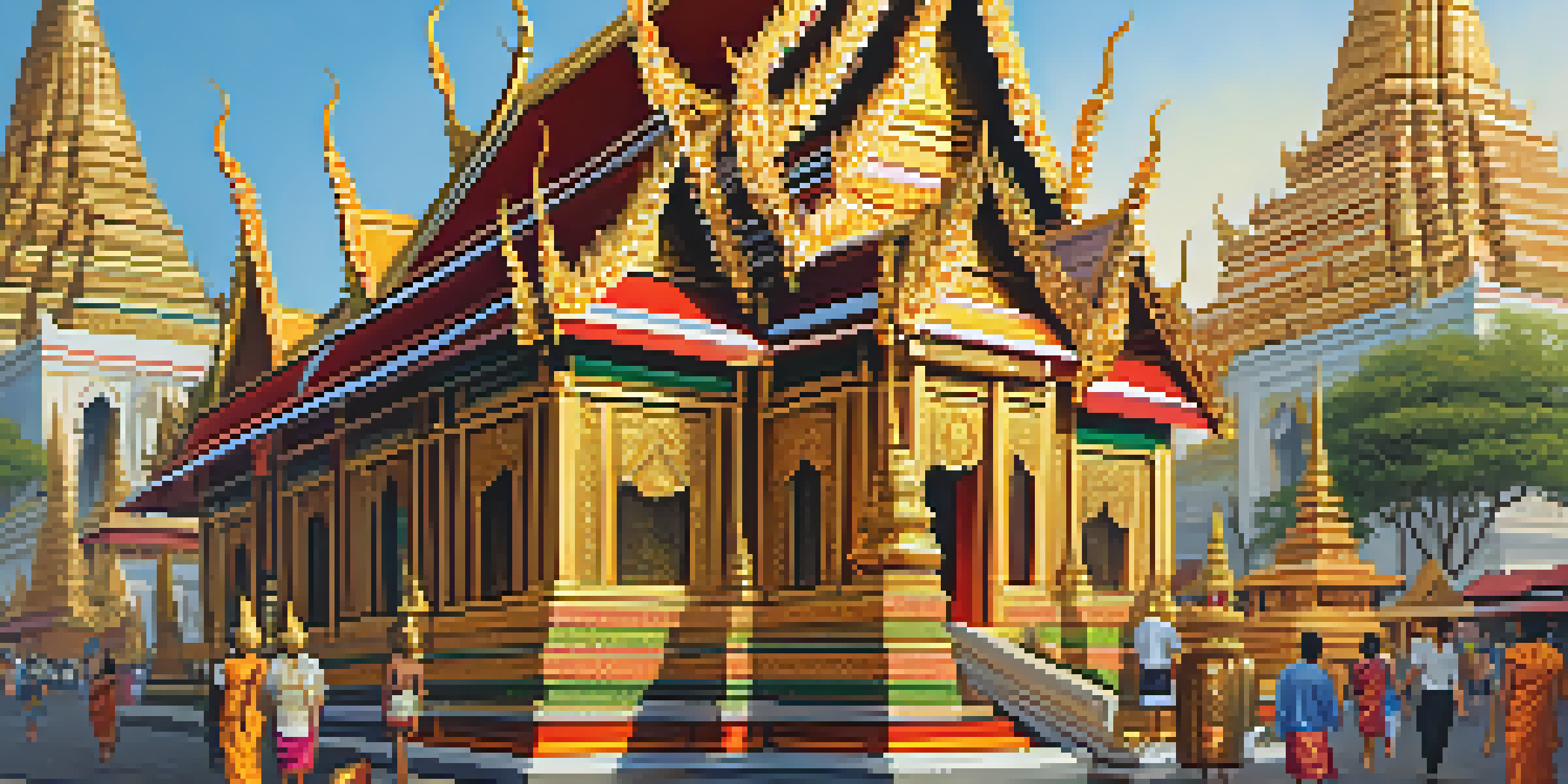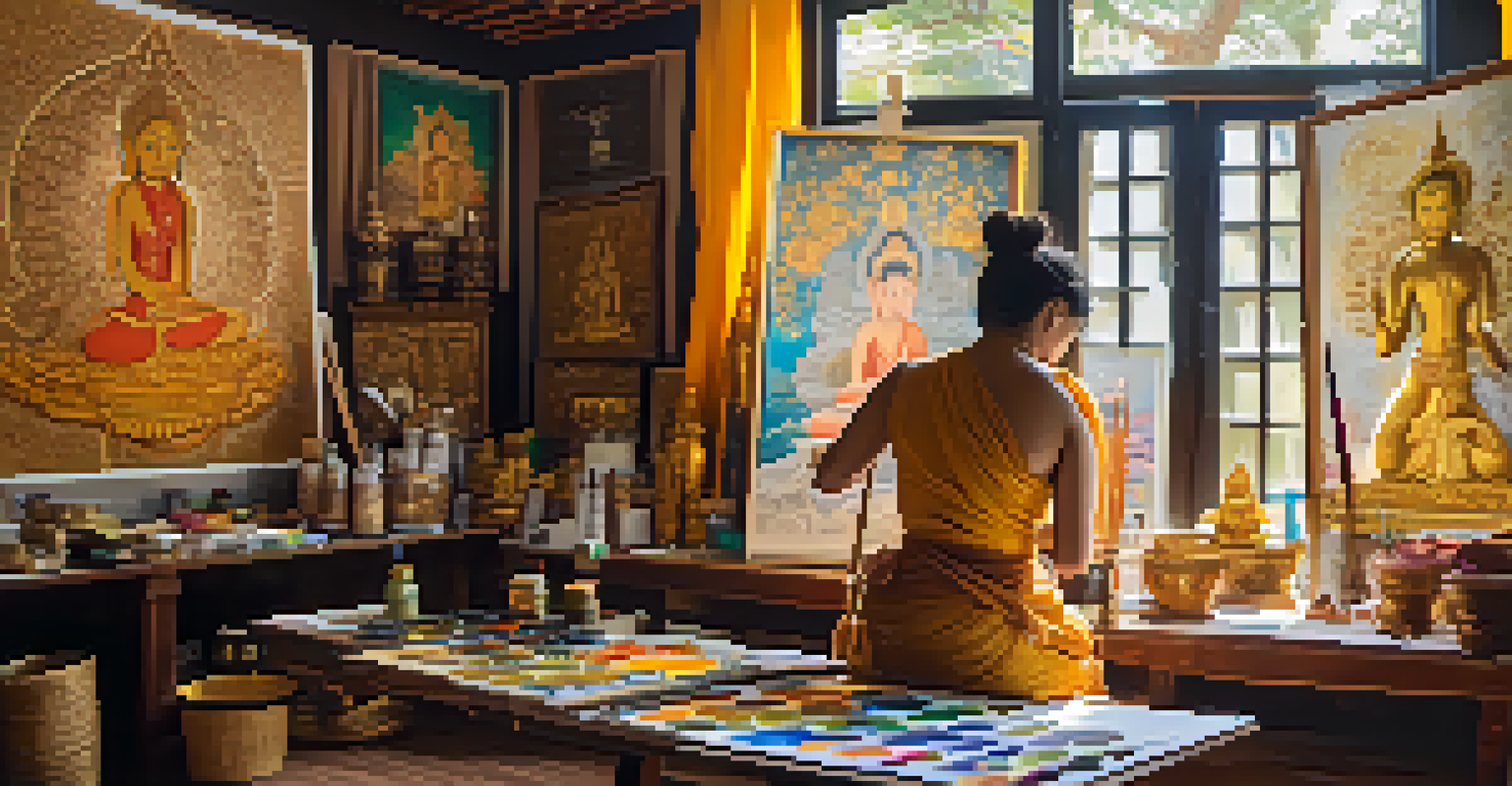Central Thai Art: A Fusion of Tradition and Modern Influence

Understanding Central Thai Art's Historical Roots
Central Thai art has deep historical roots, influenced by centuries of culture and tradition. Emerging during the Ayutthaya period, this art form encapsulates the essence of Thai identity, reflecting the country's rich history and spirituality. Temples, murals, and sculptures from this era are not just artistic expressions; they also tell stories of religious beliefs and societal values.
Art is the most beautiful of all lies; it is the truth that reveals itself through creativity.
As you stroll through the vibrant streets of Bangkok or visit ancient ruins, you can see how these historical influences are woven into the fabric of modern Thai life. For instance, the intricate designs often found in traditional textiles echo the motifs seen in ancient temple art. This connection to the past serves as a foundation for artists today, who draw inspiration from these traditional elements.
In essence, understanding the historical context of Central Thai art is crucial for appreciating its evolution. It’s like looking at a family tree; each branch tells a story of where it came from and how it grew. This rich backdrop sets the stage for the exciting developments we see in contemporary art.
Key Characteristics of Traditional Central Thai Art
Traditional Central Thai art is characterized by its vibrant colors, intricate patterns, and detailed craftsmanship. One notable hallmark is the use of gold leaf, which enhances the beauty of sculptures and murals. This technique not only reflects light beautifully but also symbolizes purity and divinity in Buddhist art.

Moreover, the themes often revolve around religious narratives, prominently featuring figures from Buddhist mythology. For instance, the depiction of the Ramakien, Thailand's national epic, showcases the blend of storytelling and artistry. This not only serves an aesthetic purpose but also educates viewers about cultural values and moral lessons.
Historical Roots of Thai Art
Central Thai art is deeply rooted in history, reflecting the cultural and spiritual essence of Thailand from the Ayutthaya period to the present.
Ultimately, the distinct characteristics of traditional Central Thai art create a captivating visual experience. It's like walking into a storybook where each page reveals a new chapter, inviting viewers to explore deeper meanings behind the vibrant imagery.
The Influence of Modernity on Central Thai Art
As society evolves, so does art. Central Thai artists today are blending traditional techniques with modern concepts, creating a unique fusion that speaks to contemporary audiences. This evolution brings forth new materials and methods, allowing for greater experimentation and expression.
Tradition is not the worship of ashes, but the preservation of fire.
For instance, some artists are incorporating mixed media and digital technology into their work, which opens up new avenues for creativity. By juxtaposing traditional motifs with modern themes, they challenge viewers to reconsider their perceptions of Thai culture. This innovative approach breathes new life into age-old practices, making them relevant in today’s fast-paced world.
In this way, modernity doesn't erase tradition; instead, it enriches it. It’s akin to adding a new chapter to a beloved book, bringing fresh insights while maintaining the core story. This dynamic interplay between old and new is what makes Central Thai art so fascinating.
Prominent Central Thai Artists Making Waves Today
Several contemporary artists are gaining recognition for their innovative contributions to Central Thai art. Artists like Rirkrit Tiravanija and Navin Rawanchaikul are pushing boundaries, blending cultural narratives with modern art forms. Their work often challenges societal norms and provokes thought, inviting viewers to engage with their surroundings in new ways.
These artists not only showcase their talent but also highlight the importance of cultural identity in a globalized world. By using their platforms, they bring attention to social issues, bridging the gap between art and activism. This is especially relevant in Thailand, where traditional values intersect with the pressures of modernization.
Modern Fusion in Thai Art
Contemporary artists are blending traditional techniques with modern concepts, creating a unique dialogue between past and present.
Through their creativity, these artists inspire the next generation to explore their own identities and express them through art. It’s much like planting seeds in fertile soil; with the right nurturing, new ideas can flourish and evolve into something extraordinary.
Exhibitions Showcasing Central Thai Art Today
Exhibitions play a pivotal role in promoting Central Thai art, offering artists a platform to showcase their work to a broader audience. Events like the Bangkok Art Biennale highlight the fusion of traditional and contemporary styles, drawing attention to emerging talents. These exhibitions not only display art but also foster dialogue about culture and identity among visitors.
Moreover, gallery spaces have become crucial for artists to engage with the public directly. Through workshops, talks, and interactive installations, audiences gain deeper insights into the artistic process and the stories behind the works. It’s a fantastic way for art to come alive and resonate personally with those who experience it.
Ultimately, these exhibitions serve as a celebration of Central Thai art, highlighting its evolution while remaining rooted in tradition. It’s like a vibrant festival where every artwork is a joyful expression, inviting everyone to join in the celebration of creativity.
The Role of Education in Promoting Central Thai Art
Education plays a crucial role in preserving and promoting Central Thai art. Art schools and cultural organizations are actively working to teach new generations about traditional techniques and the significance of cultural heritage. By instilling an appreciation for these practices, they ensure that the rich history of Thai art continues to thrive.
Furthermore, initiatives that encourage young artists to experiment with their style while respecting tradition are essential. These programs often blend workshops with mentorship opportunities, allowing emerging artists to learn from established figures in the field. This nurturing environment fosters creativity while maintaining a connection to cultural roots.
Education's Role in Art Preservation
Education is vital for preserving Central Thai art, as it nurtures new generations to appreciate and innovate upon traditional techniques.
In essence, education is the bridge that links the past with the future of Central Thai art. It’s like a relay race where each generation passes on the baton, ensuring that the legacy of creativity and expression continues to run strong.
Future Trends in Central Thai Art
Looking ahead, Central Thai art is poised for exciting developments as artists continue to explore new mediums and themes. The influence of global art movements will likely inspire local artists to experiment further, creating a vibrant tapestry of styles. This blending of influences can lead to innovative artworks that resonate with both local and international audiences.
Additionally, the rise of digital art and social media is transforming how artists present their work. Platforms like Instagram and online galleries provide new opportunities for visibility, allowing artists to reach audiences beyond their geographical boundaries. This democratization of art can foster a diverse range of voices and perspectives, enriching the landscape of Central Thai art.

Ultimately, the future of Central Thai art is bright and full of potential. It’s akin to a river flowing into uncharted territories, continually adapting and evolving while remaining true to its source. As artists navigate this exciting journey, they will undoubtedly create masterpieces that captivate and inspire for generations to come.